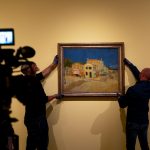Joyce Glasser reviews Exhibition on Screen: My National Gallery (June 4, 2024), Cert 12A, 98 mins. in cinemas
In 2014 the great American director Frederick Wiseman, now 94, made one of his trademark 3-hour, “fly-on-the-wall” documentaries about London’s National Gallery, bringing to life this great institution, much as he had a large hospital in NYC, the Miami Zoo, the Idaho State Legislature and the American Ballet Theatre to name but a few. Though he has been widely influential, no one has managed to nail his largely silent, observational technique. For the Gallery’s Bicentenary, directors Phil Grabsky and Ali Ray have devised a different approach that is less interested in the behind-the-scenes running of the institution than the relationship between its paintings and visitors. About half of the “viewers” are staff – whose job definitions give us an idea of what it takes to run the Gallery. We hear from a few fine art loving celebrities like Sir Michael Palin and Claudia Winkleman and a disappointingly small number of members of the public.
Each commentator walks into the room, sits in front of a painting and then tells us why it is their favourite. Many speakers include their personal relationship with the Gallery, which often includes parents taking them there as children.

HRH Princess Eugenie lets us know she is not just there for her title. Not only is her job description Director, Hauser & Worth Gallery, but she tells us, ‘I did art at school and always wanted to be an artist.’ We then get the inclusivity line, ‘but you don’t have to know anything about art history to look at art.’ Princess Eugenie’s choice is Correggio’s The Madonna of the Basket (1524), but her commentary is pedestrian. Mentioning the obvious mother/child bond with Mary putting down her “work” to pick up baby Jesus, she tells us ‘I just had my second child.’
Terry Gilliam’s comments on Agnolo Bronzini’s 1545 An Allegory of Venus and Cupid are more enlightening. Today the painting remains shockingly erotic with nudity and incestuous kissing justified by the moral subtext of the destructive power of love. Gilliam frequented the Gallery when he was around thirty for inspiration as an animator for Monty Python’s Flying Circus. He connects the painting to the 16th century epidemic of venereal disease that spread through Europe, emanating from Venus (representing Love). Cupid’s foot on the dove symbolises love crushing a life.
Gabrielle Finaldi, the Gallery’s Director, brings the most scholarly and technical analysis to back up his choice. Bartolomé Bermejo’s Saint Michael Triumphant over the Devil (circa 1468) is the first significant medieval Spanish painting to enter the collection. The Donor kneeling in the corner was a wealthy military leader and Bermejo wants us to see that he is reading a penitential psalm, looking up to St Michael for protection as he slays a terrifying devil. After 600 years, we can see the reflection of Jerusalem – of which St Michael is guardian – on the armour.
This structure, a sequence of one visitor after another offering what is in essence a spotted Gallery tour, is a novel approach and it’s fun to be surprised by who chooses what painting, even if the format grows a bit repetitive.
Thankfully, historian Jonathan Conlin is on hand to break up the sequence with short historical segments, which include the various locations and transformational architecture of the Gallery. We also learn, that, thanks to then-Director Kenneth Clark listening to a suggestion from a member of the public, the Gallery was unique in the UK in remaining open during WWII when the One-Painting Show, and a piano recital became the cultural hub of wartime London.
While the visitors’ selections focus us on some paintings we might not have seen, or paid attention to, you may get the impression that the speakers and the paintings are chosen for their diversity. For one thing, conveniently no one shares the same favourite. For another, popular paintings, like Vermeer’s Lady with a Balance or Van Gogh’s Sunflowers, are not mentioned. It’s as if they don’t need the PR. That said, Leonardo da Vinci’s Virgin of the Rock is chosen (by Claudia Winkleman), with an uninspired commentary.

Enthusiastic security officer Alan Allison, tells us he likes to read up on the art and show it off to visitors, although ‘I haven’t seen many paintings that represent myself.’ Nor has British sign language guide and lecturer John Wilson, who is deaf. He can however identify with Clara, a rhinoceros in 18th century Venice in Pietro Longhi’s Exhibition of a Rhinoceros. The painting shows a small group of observers, dressed for the Carnival, studying the animal in order to understand it, just as, Wilson recalls, people wanted to study his deafness when he was a child.
Women are not well represented in the Gallery either, so it’s convenient that the popular Artemisia Gentileschi’s Self-Portrait as St Catherine of Alexandria is someone’s favourite. Gentileschi was the subject of an exhibition by the Gallery, but not so Rosa Bonheur whose painting The Horse Fair is hardly noticed (if and when on show). She was, however, the most sought after female artist in 19th century Europe and America and the first female artist awarded la Legion d’honneur.
The “My” and “National” in the title are awkward, particularly since Brexit, as this is an overwhelmingly European collection that stops before WWI and it contains no sculptures. The history of British, and particularly English, painting is in the Tate Britain and the modern collections are in the other Tates. It is of course worth mentioning that Wales, Scotland and Northern Ireland have their own national galleries.




